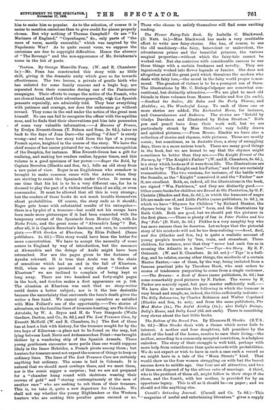The Flower Fairy - Tale Book. By Isabella C. Blackwood. (D. Nutt.
Os )—Miss Blackwood has made a very creditable effort to write new fairy-stories. She has, of course, to use the old machinery—the fairy, benevolent or malevolent, the adventurous prince and the beautiful princess, the various magical properties—without which the fairy-tale cannot be worked out. But she contrives with considerable success to use these things with a certain freshness and novelty. They are ingeniously worked into flower legends or fancies. She does not altogether avoid the great peril which threatens the modern who deals with fairy lore,—the moral in the fairy world proper is non- moral. The greatest of virtues is to be a youngest son of three. The illustrations by Mr. C. Bishop-Culpeper are somewhat con- ventional, but distinctly attractive.—We are glad to meet old friends in three volumes from Messrs. Blackie and Son (ls. each), --Sindbad the Sailor, Ali Baba and the Forty Thieves, and Aladdin; or, The Wonderful Lamp. To each of these one or more stories are added, The Enchanted Horse, for instance, and Camaraisaman and Badoura. The stories are " Retold by Gladys Davidson and Illustrated by Helen Stratton." Both pen and pencil have done their work well, but we are particularly struck by Miss Stratton's very boldly drawn and spirited pictures.—From Messrs. Blackie wo have also a collection of stories and rhymes, with pictures. These are mostly comic; but sometimes, as in Bastable Cove, a story of smuggling days, there is a more serious touch. There are many good things in the book, but we are bound to say that the rhymes might sometimes be better than they aro.—The Knight Errant of the Nursery, by " The Knight's Father " (W. and R. Chambers, 3s. 6d.), is a story which looks as if it were from life. The illustrations are said to be by "The Knight and his Father," and they are certainly vraisemblables. The two versions, for instance, of the battle with the Somalis, as the " Knight" conceived it and the "Father" saw it, are excellent. Both, as, indeed, all the illustrations in the book, are signed " Wm. Parkinson," and they are distinctly good.— Other comic books for children are Round de Ole Plantation, by G. F. Christie (Blackie and Son, 2s. 6d.), in which the humours of negro life are made use of, and Little Pickles (same publishers, ls. 6d.), in which we have "Rhymes for Children" by Richard Hunter, the rhymes being in the " Limerick " form, and the illustrations by Ruth Cobb. Both are good, but we should put the pictures in the first place.—There is plenty of fun in Peter Pickles and his Dog Ado' (D. Nutt, 2s. 6d.) Pickles is a very naughty boy who has more success than he deserves. Let us hope that the pictorial story of his misdeeds will not be too demoralising.—Road, Rail, and Sea (Blackie and Son, ls.) is quite a realistic account of young people's travels by 'bus, train, and steamboat. Three children, for instance, aver that they " never had such fun as in crossing the Atlantic in a liner."—Tige—his Story. By R. F. Outcault. (W. and R. Chambers. 2s. 6d. net.)—` Tige ' is a bull- dog, and he relates, among other things, the misdeeds of a certain Master Baxter,—one of them, by the way, being imitated from a famous practical joke by Theodore Hook, who sent orders to scores of tradesmen purporting to come from a single customer, —The Browns : a Book of Bears (same publishers, 8s. 6d.) has some remarkably good pictures by N. Parker. The verses by B. Parker are scarcely equal, but pass muster sufficiently well.— We have also to mention the following in which the humour is very broad and simple, as, indeed, the titles sufficiently indicate:— The Silly Submarine, by Charles Robinson and Walter Copeland (Blackie and Son, ls. net); and from the same publishers, The Mad Motor (1s.), The Awful Airship (1s.) ; also Dolly's Doings, Dolly's House, and Dolly Land (6d. net each). There is something very clever about the last little books.


























































 Previous page
Previous page